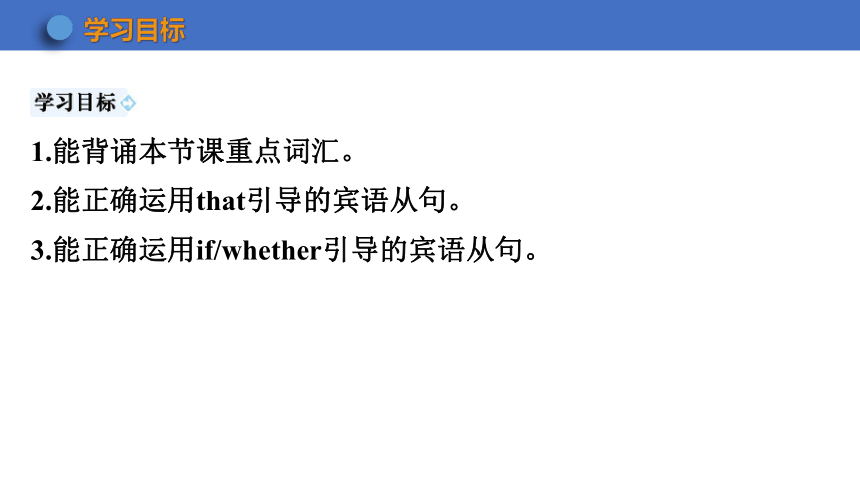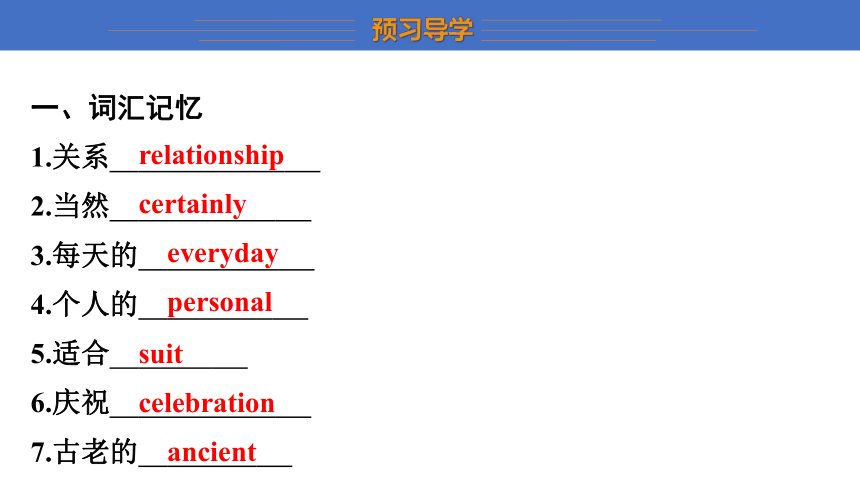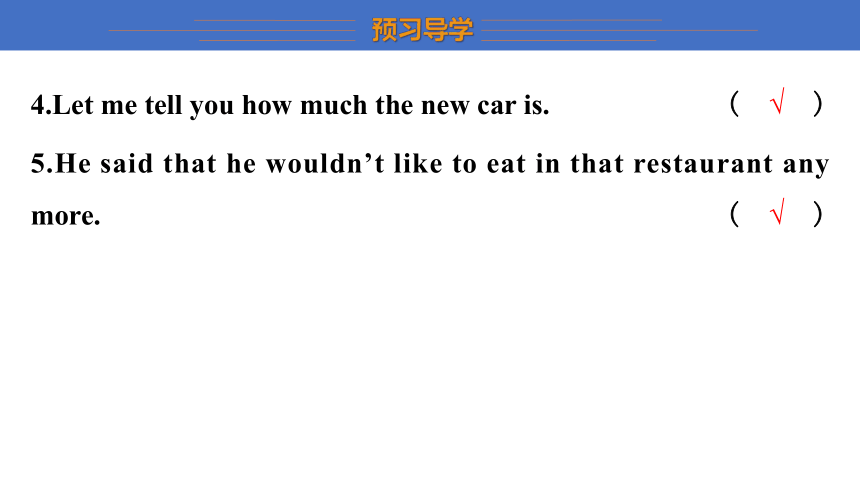Unit 2 Colour Grammarf教学课件 (共25张PPT)
文档属性
| 名称 | Unit 2 Colour Grammarf教学课件 (共25张PPT) |  | |
| 格式 | pptx | ||
| 文件大小 | 831.8KB | ||
| 资源类型 | 教案 | ||
| 版本资源 | 牛津译林版 | ||
| 科目 | 英语 | ||
| 更新时间 | 2024-01-12 19:55:56 | ||
图片预览









文档简介
(共25张PPT)
九年级·英语·译林版·全一册
Unit 2 Colours
Grammar
1.能背诵本节课重点词汇。
2.能正确运用that引导的宾语从句。
3.能正确运用if/whether引导的宾语从句。
1.完成任务驱动一, 达成学习目标1、2。
2.完成任务驱动二, 达成学习目标1、3。
播放你精心挑选的歌曲后,问学生: What do you think of the song? 由学生回答I think it is...引出宾语从句。
·导学建议·
安排预习任务,让学生了解宾语从句的含义和本节课出现的宾语从句类型。
◎学法指导:1.思考宾语从句出现的语言环境是什么;2.学会按照引导词的不同将宾语从句分类。
一、词汇记忆
1.关系 relationship
2.当然 certainly
3.每天的 everyday
4.个人的 personal
5.适合 suit
6.庆祝 celebration
7.古老的 ancient
relationship
certainly
everyday
personal
suit
celebration
ancient
8.好运 good luck
9.深颜色 dark colours
10.由……制成 made of...
11.代替 instead of
good luck
dark colours
made of...
instead of
二、判断(打√)下列句子哪些是宾语从句
1.I think that people there are very friendly. ( √ )
2.Can you go to that shop with me at 3:00 this afternoon?( )
3.She doesn’t know if her mother will come here tomorrow.( √ )
√
√
4.Let me tell you how much the new car is. ( √ )
√
5.He said that he wouldn’t like to eat in that restaurant any more. ( √ )
√
三、想一想
你觉得什么样的句子是宾语从句,与同伴交流,写出你们的结论。
宾语从句,是名词性从句的一种,在主从复合句中充当动词、介词的宾语,这种从句称为宾语从句。简单地说就是在复合句中做宾语的一个句子叫宾语从句。
宾语从句,是名词性从句的一种,在主从复合句中充当动词、介词的宾语,这种从句称为宾语从句。简单地说就是在复合句中作宾语的一个句子叫宾语从句。
学习由that引导的宾语从句
·导学建议·
安排学生三人一组进行“传话”游戏,通过转述别人的话来练习宾语从句。
◎学法指导:结合汉语,对比学习。注意人称和时态的变化。
1.探究宾语从句结构,了解宾语从句的概念。
宾语从句的概念:在主从复合句中,作 宾语 的句子就叫宾语从句。它位于主句的谓语动词之 后 。主句和从句之间的that叫 引导词 ,在句中无词义,在口语中可以 省略 。
宾语
后
引导词
省略
2.that引导的宾语从句是由陈述句转化而来。回答下列问题,掌握宾语从句的转化方法, 观察时态和人称的变化。
Helen says,“I have trouble learning Chinese.”
What does Helen say? What did Helen say?
↓ ↓
She says that she has trouble learning Chinese.
She said that she had trouble learning Chinese.
宾语从句的人称变化要根据句子的 实际情况 而定;宾语从句的时态变化要根据 主句 的时态而定。主句是一般现在时态,从句根据需要用相应的 任何 时态;主句是一般过去时态,从句用与 过去 有关的相应时态。如:
实际情况
主句
任何
过去
I think that I will make my dream come true.
I was sure that she would come back soon.
will
would
学习由if/whether引导的宾语从句
·导学建议·
创设具体场景,举例说明if/whether引导的宾语从句和that引导的宾语从句的区别。
◎学法指导:掌握宾语从句三要素:引导词、语序和时态。
1.探究宾语从句结构,掌握宾语从句的语序。
I ask if/whether he is from Japan?
I wonder if/whether they visited the Great Wall last Sunday.
探究总结:
以上两个例子均是 疑问句 作宾语从句,此时宾语从句要由原来的 疑问句 语序转化为 陈述句 语序。例①把变疑问句时提前的 be 动词重新放在 主语 之后;例②把变疑问句时添加的助动词 did 去掉,谓语动词 visit 仍用原来的过去式。具体变化要视不同的情况具体变化。总之,宾语从句不能用疑问句语序,因为此时不再是提出疑问。
疑问句
疑问句
陈述句
be
主语
did
visit
2.与同伴交流,判断下列句子是(√)否(×)正确使用了陈述句语序。你能改正错误的地方吗?
①I want to know if is he the winner. ( × )
is he改为he is
②She asked me whether I did drove to work yesterday. ( × )
删除did
③I don’t know if this red pencil is hers. ( √ )
×
is he改为he is
×
删除did
√
④Go and ask her whether can she come to my birthday. ( × )
can she改为she can
⑤The teacher is worried about if it will rain tomorrow. ( √ )
×
can she改为she can
√
3.完成教材中B部分的练习。
I think colours influence our everyday lives in many ways.我认为颜色会在很多方面影响我们的日常生活。
词性 意思 用法 例句
every day 短语 每天 常放在句末作状语 She goes to school with her brother every day.她每天跟她弟弟一块去上学。
everyday 形容词 每天的;日常的…… 常放在名词前面作定语 Can you speak everyday English? 你会说日常英语吗?
用every day或everyday填空。
My father gets up at six in the morning 1. every day .After breakfast he works in a factory.He eats lunch there 2. every day .After work he comes back home at seven in the evening.This is my father’s 3. everyday life.What he does 4. every day is to make us have a good life.
every
day
every day
everyday
every day
It is often used for celebration!它常在庆祝活动中被使用!
◎用法总结:
1.be used for+名词/动名词,意为“被用来……”,强调主语的用途。如:
This microphone is used for singing.这个话筒是唱歌用的。
2.be used to+动词原形,意为“被用来……”,强调主语适合……。如:
Wood is used to make paper.木材用来造纸。
3.be used to+动名词,意为“习惯于……”,强调主语的习惯。如:
My father is used to drinking tea after meals.我爸爸习惯于饭后喝茶。
用所给词的正确形式填空。
1.I’m used to walking (walk) to school.It’s a good way to exercise.
2.The knife was used to cut (cut) meat.But now it is broken.
3.—What is this?
—Oh, it’s a bottle-opener.It’s used for opening (open) a bottle.
walking
cut
opening
九年级·英语·译林版·全一册
Unit 2 Colours
Grammar
1.能背诵本节课重点词汇。
2.能正确运用that引导的宾语从句。
3.能正确运用if/whether引导的宾语从句。
1.完成任务驱动一, 达成学习目标1、2。
2.完成任务驱动二, 达成学习目标1、3。
播放你精心挑选的歌曲后,问学生: What do you think of the song? 由学生回答I think it is...引出宾语从句。
·导学建议·
安排预习任务,让学生了解宾语从句的含义和本节课出现的宾语从句类型。
◎学法指导:1.思考宾语从句出现的语言环境是什么;2.学会按照引导词的不同将宾语从句分类。
一、词汇记忆
1.关系 relationship
2.当然 certainly
3.每天的 everyday
4.个人的 personal
5.适合 suit
6.庆祝 celebration
7.古老的 ancient
relationship
certainly
everyday
personal
suit
celebration
ancient
8.好运 good luck
9.深颜色 dark colours
10.由……制成 made of...
11.代替 instead of
good luck
dark colours
made of...
instead of
二、判断(打√)下列句子哪些是宾语从句
1.I think that people there are very friendly. ( √ )
2.Can you go to that shop with me at 3:00 this afternoon?( )
3.She doesn’t know if her mother will come here tomorrow.( √ )
√
√
4.Let me tell you how much the new car is. ( √ )
√
5.He said that he wouldn’t like to eat in that restaurant any more. ( √ )
√
三、想一想
你觉得什么样的句子是宾语从句,与同伴交流,写出你们的结论。
宾语从句,是名词性从句的一种,在主从复合句中充当动词、介词的宾语,这种从句称为宾语从句。简单地说就是在复合句中做宾语的一个句子叫宾语从句。
宾语从句,是名词性从句的一种,在主从复合句中充当动词、介词的宾语,这种从句称为宾语从句。简单地说就是在复合句中作宾语的一个句子叫宾语从句。
学习由that引导的宾语从句
·导学建议·
安排学生三人一组进行“传话”游戏,通过转述别人的话来练习宾语从句。
◎学法指导:结合汉语,对比学习。注意人称和时态的变化。
1.探究宾语从句结构,了解宾语从句的概念。
宾语从句的概念:在主从复合句中,作 宾语 的句子就叫宾语从句。它位于主句的谓语动词之 后 。主句和从句之间的that叫 引导词 ,在句中无词义,在口语中可以 省略 。
宾语
后
引导词
省略
2.that引导的宾语从句是由陈述句转化而来。回答下列问题,掌握宾语从句的转化方法, 观察时态和人称的变化。
Helen says,“I have trouble learning Chinese.”
What does Helen say? What did Helen say?
↓ ↓
She says that she has trouble learning Chinese.
She said that she had trouble learning Chinese.
宾语从句的人称变化要根据句子的 实际情况 而定;宾语从句的时态变化要根据 主句 的时态而定。主句是一般现在时态,从句根据需要用相应的 任何 时态;主句是一般过去时态,从句用与 过去 有关的相应时态。如:
实际情况
主句
任何
过去
I think that I will make my dream come true.
I was sure that she would come back soon.
will
would
学习由if/whether引导的宾语从句
·导学建议·
创设具体场景,举例说明if/whether引导的宾语从句和that引导的宾语从句的区别。
◎学法指导:掌握宾语从句三要素:引导词、语序和时态。
1.探究宾语从句结构,掌握宾语从句的语序。
I ask if/whether he is from Japan?
I wonder if/whether they visited the Great Wall last Sunday.
探究总结:
以上两个例子均是 疑问句 作宾语从句,此时宾语从句要由原来的 疑问句 语序转化为 陈述句 语序。例①把变疑问句时提前的 be 动词重新放在 主语 之后;例②把变疑问句时添加的助动词 did 去掉,谓语动词 visit 仍用原来的过去式。具体变化要视不同的情况具体变化。总之,宾语从句不能用疑问句语序,因为此时不再是提出疑问。
疑问句
疑问句
陈述句
be
主语
did
visit
2.与同伴交流,判断下列句子是(√)否(×)正确使用了陈述句语序。你能改正错误的地方吗?
①I want to know if is he the winner. ( × )
is he改为he is
②She asked me whether I did drove to work yesterday. ( × )
删除did
③I don’t know if this red pencil is hers. ( √ )
×
is he改为he is
×
删除did
√
④Go and ask her whether can she come to my birthday. ( × )
can she改为she can
⑤The teacher is worried about if it will rain tomorrow. ( √ )
×
can she改为she can
√
3.完成教材中B部分的练习。
I think colours influence our everyday lives in many ways.我认为颜色会在很多方面影响我们的日常生活。
词性 意思 用法 例句
every day 短语 每天 常放在句末作状语 She goes to school with her brother every day.她每天跟她弟弟一块去上学。
everyday 形容词 每天的;日常的…… 常放在名词前面作定语 Can you speak everyday English? 你会说日常英语吗?
用every day或everyday填空。
My father gets up at six in the morning 1. every day .After breakfast he works in a factory.He eats lunch there 2. every day .After work he comes back home at seven in the evening.This is my father’s 3. everyday life.What he does 4. every day is to make us have a good life.
every
day
every day
everyday
every day
It is often used for celebration!它常在庆祝活动中被使用!
◎用法总结:
1.be used for+名词/动名词,意为“被用来……”,强调主语的用途。如:
This microphone is used for singing.这个话筒是唱歌用的。
2.be used to+动词原形,意为“被用来……”,强调主语适合……。如:
Wood is used to make paper.木材用来造纸。
3.be used to+动名词,意为“习惯于……”,强调主语的习惯。如:
My father is used to drinking tea after meals.我爸爸习惯于饭后喝茶。
用所给词的正确形式填空。
1.I’m used to walking (walk) to school.It’s a good way to exercise.
2.The knife was used to cut (cut) meat.But now it is broken.
3.—What is this?
—Oh, it’s a bottle-opener.It’s used for opening (open) a bottle.
walking
cut
opening
